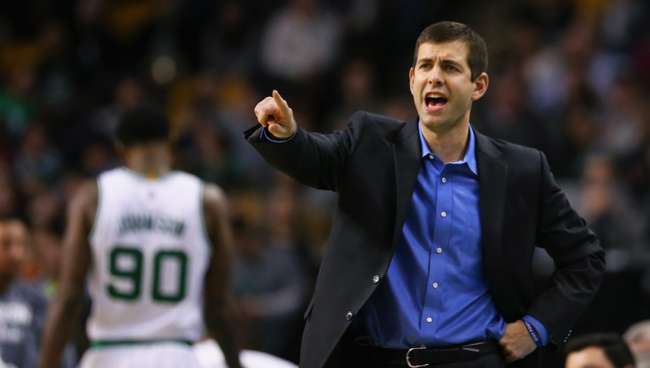
Welcome to “Basketball, Neat.” This is an intermittent column throughout the 2015-16 NBA season where DIME will discuss some basketball play or trend without extraneous information.
If you’re a fan of single-malt Scotch, you should be familiar with ordering a drink, neat. That’s what this is, but with basketball. So, there will be none of the usual contextual or superficial noise you might hear on Twitter or even in our pieces at DIME. This isn’t some referendum on basketball coverage or anything quite so lofty; it’s just a tiny place to talk exclusively about hoops. We’d like to nerd out about basketball for a little bit before we go back to the overarching culture of basketball and the NBA we normally cover. We hope you like it, but it’s primarily just a selfish way to publish what we’re already talking about with each other.
Jack: There’s no consensus on what makes the Boston Celtics a likely playoff team in the much-improved Eastern Conference. The makeshift roster Danny Ainge has assembled while waiting to land a big fish is certainly underrated. Isaiah Thomas is a devastating offensive lead guard; Avery Bradley a bonafide two-way impact player; Jae Crowder one of the game’s most versatile forwards; and Boston’s frontcourt loaded with quality, myriad depth.
The Celtics don’t have a superstar, but do boast a group of players young and old that’s the envy of many, many teams in the NBA. These guys are good. It’s certainly safe to say, though, that Boston is better than the sum of its perpetually underrated parts – and the guidance of Brad Stevens is the biggest reason why.
The third-year coach has instilled an “all for one” mantra in the Celtics that’s come to define the franchise in the early stages of its post-Big Three era. But while moving the ball, rotating on an aggressive string, and playing with unmitigated intensity is what makes Boston a threat to win on a nightly basis, it’s the possession-specific minutiae oft initiated by Stevens that allows his team a better chance for victory than that of most any other coach.
And this set play at the end of the first half of Boston’s Sunday loss to the Memphis Grizzlies makes that reality abundantly clear.
This set’s success largely depends on its initial threat: Thomas rushing the ball up the floor to find a shot for his team before the game clock strikes zeroes. The Celtics’ point guard is a blur in the open floor, certainly capable of going the distance for a layup in 4.7 seconds if matched-up with a single defender.
Marc Gasol knows that, of course, and reacts accordingly as Thomas whirls around a screen from Kelly Olynyk, leaving center field to cut off the far sideline.
That decision is fine by itself. Gasol is “guarding” Amir Johnson here, who’s inbounding the ball from under his own basket. The Grizzlies big man is tasked with limiting the potential effect of Boston’s most immediate threat, and in this case it’s most certainly Thomas turning the corner around Elliot Williams and continuing up the sideline unmolested.
But Gasol’s instant attention to the ball leaves the Celtics with an even numbers game Stevens is confident they can win considering the ample space with which to operate. And once Bradley catches Vince Carter with a clean back screen and Memphis fails to communicate through that action, the only thing keeping Boston from an easy two points is simple execution.
Spencer: This sort of ball watching is inevitable for Memphis. The clock is ticking down, and the Grizzlies are already thinking about lounging in the locker room before the second half. Plus, Gasol is a defensive whiz and appears to have angled Zeke to the sideline, where he’ll run out of real estate.
That’s why Tony Allen and Vince Carter fail to communicate on the back screen Bradley sets. The play is effectively over for them, and their guy Gasol has corralled the real threat for a last-second shot. Look where their heads are turned; they’re spying the ball and not their assignments.
That’s also why Matt Barnes is lulled into letting Evan Turner catch the hockey assist from Thomas. Turner isn’t a great shooter, and Barnes is right there, so there’s no need to deny even though Thomas likely would have dribbled out of bounds if Turner hadn’t acted as a release valve.
But when you add up all that seeming comfort that the Grizzlies will get the stop, it leads to a last-second hoop. And Stevens plays on that notion and not just with the play itself.
How many times do teams need a bucket, but ALSO have to go the length of the court? If you’re Boston, it’s not many. Stevens usually saves a timeout or two to advance the ball. That’s coaching 101 and Stevens is a great coach.
But the Celtics have obviously practiced this play because the timing was just too good. Thomas really does look like the primary culprit, which is why using him as the initial instigator was so smart. Would Matt Barnes have even let Isaiah catch the ball if he and Turner switched spots on the floor? What about Olynyk, who sneaks behind all of them on the back-screen? No way. Thomas is Boston’s most talented offensive weapon, and the Grizzlies never would have let him sneak to the hoop like that.
But Olynyk? That’s a guy who — despite the pale skin and Spicoli hair — can fly under the radar until it’s too late. He’s not a threat here, which Stevens adroitly uses to their advantage.
Now the Grizzlies came back in the second half to win, and the Celtics are still one or two superstars away from threatening Cleveland in the East, but they’ve got the cap room, picks, rotational players and coach of a title contender. This play is just more proof.






